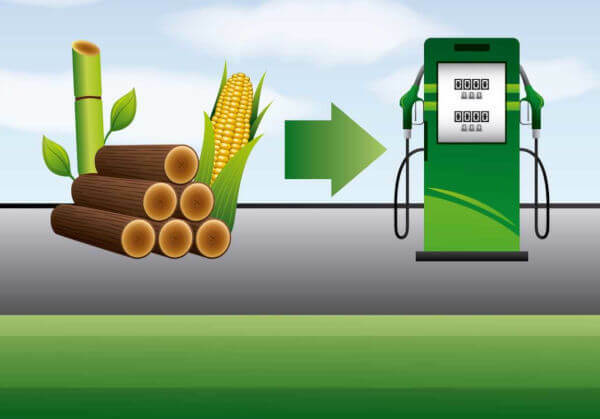Bioenergy is the name given to energy from biomass, that is, organic matter of plant and animal origin. This type of energy can be used to produce fuels, electricity and heat. considered an alternative to conventional energy sources, which are in force in the energy matrix worldwide.
Know more:What are alternative energy sources?
Main sources for bioenergy production
Bioenergy can be produced through sources from renewable raw materials, such as:
Wood;
Agricultural products (corn, cereals);
Sugarcane bagasse;
Organic waste (sawdust, organic waste);
Vegetables and fruits.
These sources are classified into four categories:
1.Cultures: agricultural products cultivated for energy production, such as corn and cereals.
2. Agricultural and forestry waste: residues produced during harvesting and felling of trees, such as straw and wood residues.
3. Organic by-products: organic residues, agricultural effluents and residues from wood processing.
4. Organic waste: domestic waste, domestic and industrial effluents and residues from food production.
Biomass and Bioenergy
THE biomass, organic matter used for energy production, can be of vegetable or animal origin. This organic matter produces the bioenergy, a renewable, clean, low-cost energy that does not emit polluting gases into the atmosphere.
Despite releasing carbon dioxide, burning biomass for bioenergy production does not change the atmosphere, as this gas is used by plants in the photosynthesis process.
There are three classes of biomass:
1. solid biomass: agricultural, forestry products and residues and biodegradable residues from industries and urban areas.
2. Liquid biomass: coming from "energy crops", results in liquid biofuels, such as ethanol and biodiesel.
3. gaseous biomass: can be found in agricultural effluents from industry and urban areas.
The use of biomass became more present in energy matrices due to the exhaustion of some non-renewable energy sources, becoming an alternative to the global energy matrix.
Furthermore, the production of bioenergy represents a response to the appeal of the scientific community regarding the negative impacts caused to the environment.
Fuels such as ethanol and biodiesel are one of the main products from biomass. These biofuels, in addition to being more economical, are sustainable, since their production does not emit polluting gases into the atmosphere.
However, it is worth noting that the use of biomass for energy production is associated with some environmental problems, such as the intensification of deforestation to make agricultural production viable. This removal of vegetation cover causes several problems, such as ecological imbalance, loss of animal habitat and climate change.
Importance of Bioenergy
Bioenergy is a clean and renewable energy source. Therefore, it represents an alternative to the global energy matrix, which is dependent on non-renewable energy sources, especially the fossil fuels.
In addition to emitting less pollutants, the energy generated by biomass allows the reuse of waste that is normally discarded.
According to the scientific director of the Foundation for Research Support of the State of São Paulo (Fapesp), Carlos Henrique, bioenergy could be a solution for the damage caused to the environment.
Read too:Biodiesel in Brazil
Fuels produced through bioenergy

Biofuels can be produced using agricultural products such as corn, wood and sugarcane.
Ethanol is produced from agro-industrial residues such as corn and sugarcane. In Brazil, its production intensified in 1975 with the National Alcohol Program. In 1994, it started to represent around 50% of the country's national fuel consumption.
Biodiesel is produced from vegetable oils. It represents an alternative to the use of diesel oil, however it is not a completely clean fuel, as its production generates emission of polluting gases.
Biogas is a fuel with high calorific value, gaseous and composed mainly of methane. This fuel can be used to replace the use of natural gas, resulting from non-renewable energy sources.
→ Biomethane
Biomethane is produced by cleaning and purifying biogas and is mainly made up of methane. It can be obtained from wastewater treatment plants, landfills, or livestock waste. Brazil produces about 30 million m3 of biomethane per day.
Advantages and disadvantages
Although bioenergy represents an alternative energy source to the current energy model, its use and production have some disadvantages. Below are some of these advantages and disadvantages:
Benefits
- Is renewable energy source;
- Generates few pollutants when compared to the use of non-renewable energy sources;
- It has low cost and high capacity for reusing waste;
- Presents lower environmental risk;
- Does not contribute to the intensification of greenhouse effect.
Disadvantages
- Causes deforestation of extensive areas, resulting in habitat loss, ecological imbalance and climate change;
- Has lower calorific value when compared to other fuels;
- Has greater difficulty in transporting and storing solid biomass;
- Has reduced efficiency;
- Liquid biofuels can cause an increase in acid rain.
Bioenergy in Brazil
Bioenergy production in Brazil is related to the use of primary sources, such as sugarcane bagasse and wood. According to the Food and Agriculture Organization of the United Nations, Brazil occupies the second position in the production of bioethanol in the world.
Biomass is also widely used to produce electricity in Brazil, second only to hydroelectricity. About 43% of the energy produced in the country comes from renewable sources. Today, sugarcane corresponds to approximately 17% of the Brazilian energy matrix.

One of the main sources used for the production of biofuels in Brazil is sugarcane bagasse.
In 2016, the Ministry of Mines and Energy announced that biomass is the second most important source of energy generation in Brazil. Data released by Resenha Energética Brasileira in the same year indicated that bioenergy corresponds to 29.9% of the country's energy matrix.
The greatest potential for energy production from biomass is in the Southeast region, especially in the state of São Paulo.
Challenges
Bioenergy presents two problems for the environment: removal of vegetation cover from large areas for agricultural production and the use of large amounts of water.
Another concern is the demand for food, which can be harmed by agricultural production aimed at obtaining energy.
Thus, it is up to society and governments to find a way to increase the use of bioenergy without causing major negative impacts on the environment and without affecting food production.
by Rafaela Sousa
Graduated in Geography


